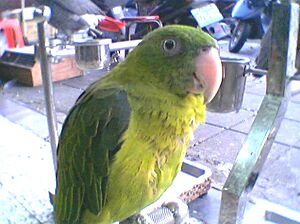Azure-rumped parrot facts for kids
Quick facts for kids Azure-rumped parrot |
|
|---|---|
 |
|
| Adult male on a postage stamp | |
 |
|
| Female in captivity | |
| Conservation status | |
| Scientific classification | |
| Genus: |
Tanygnathus
|
| Species: |
sumatranus
|
The azure-rumped parrot (scientific name: Tanygnathus sumatranus) is a large, colorful bird that lives only in Indonesia. This means it is endemic to that country. You can find it on the islands of Sulawesi and the Sangir Islands. This parrot is known for its bright blue rump, which is the lower part of its back.
These parrots live in forests. They often fly in small groups, and sometimes they are active even at night! Sadly, these beautiful birds face dangers. They are losing their homes because of deforestation, and some are caught to be sold as pets.
What Does It Look Like?
The azure-rumped parrot is a medium-sized bird, about 32 centimeters (or about 12.5 inches) long. It is mostly green. Its wings have yellowish edges, and it has bright blue patches on its rump and on the bends of its wings.
The top of its head, its back, wings, and tail are a darker green. Its belly and the area around its neck are a lighter green.
Boys and girls (males and females) of this parrot look a little different. This is called being sexually dimorphic. The male parrot has a bright red beak. The female parrot, on the other hand, has a pale yellow or horn-colored beak.
Where Does It Live? (Subspecies)
There are two main types, or subspecies, of the azure-rumped parrot. A subspecies is a group of animals within a species that has small differences, often because they live in different places.
- Tanygnathus sumatranus sumatranus: This subspecies lives on Sulawesi and other nearby islands. It has a yellow iris (the colored part of its eye).
- Tanygnathus sumatranus sangirensis: This subspecies lives on the Sangir Islands and Karakelong. It has more blue on its wing bends and wing feathers. Its head is also a darker green. Like the other subspecies, it also has a yellow iris.
Scientists at the International Ornithological Congress officially recognized both of these subspecies in 2022. They used special evidence to show that these two groups are distinct.


